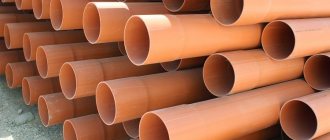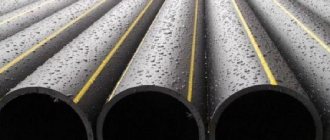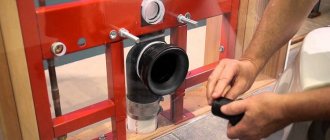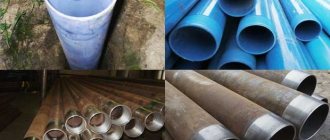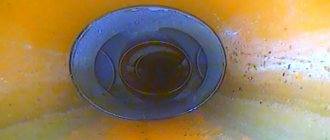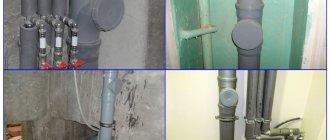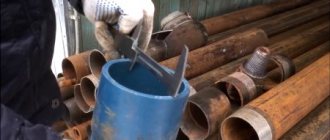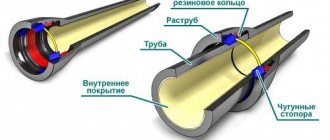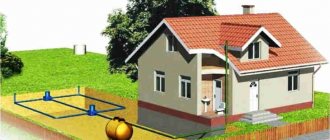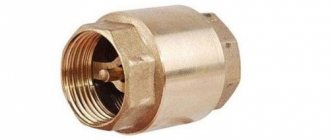- Marking of polyethylene pipes
- What does SDR mean?
- Difference between pipes with different SDR
Polyethylene pipes, like other building materials, have a marking system. This approach allows the buyer to understand the technical and quality characteristics of the product, determine the purpose of a particular pipe and its ability to cope with loads.
It is allowed to add additional information to the GOST-approved marking of PE pipes (For more details, see the article GOSTs for polyethylene (HDPE) pipes) - for example, some manufacturers indicate the company logo and address on the product. But there is information that the manufacturer must include. One of them is SDR.
What are SDR and PE?
SDR is the ratio of the outer diameter of a polyethylene (or any other) pipe to its wall thickness. Thus, with an increase in the SDR index, the pipe wall becomes thinner, and vice versa, the wall thickness increases with a decrease in the index.
After the prefix PE (“polyethylene”), manufacturers indicate the brand of polyethylene. Nowadays, PE-80 and PE-100 are most often found.
The materials have some differences:
- PE 100 has a more ordered crystal lattice structure, due to which, after welding, a stronger and more uniform weld can be obtained.
- However, due to the first difference, PE 80 polyethylene requires a lower temperature for soldering.
- PE 100 grade material is generally more dense and durable, which means it can be used in more severe operating conditions.
- The production of pipes of the required diameter will require a larger amount of PE 80 polyethylene (compared to its analogue), which increases the cost of the final product, as well as the cost of delivering it to the construction site
Advice from a professional: There may be an opinion that since grade 100 polyethylene is more reliable, resistant and cheaper, it is better to use only it. However, in practice, each type of pipe has found its optimal application. Let's look at them in more detail.
Areas of household application for polypropylene (PP) pipes and their operational parameters
Polypropylene pipelines connected by soldering are widely used in households for laying internal communications for cold and hot water supply, heating, as well as externally in caisson wells.
There are three main types of polypropylene pipes: from the usual random copolymer PP-R, reinforced with fiberglass and aluminum foil. More modern developments from the world's leading manufacturers made from heat-stabilized or basalt fiber-reinforced PP are much more expensive than traditional ones and are not so often found on the market.
What does SDR consist of?
SDR (from English Standard Dimension Ratio - standard dimensional ratio) is a dimensional characteristic of a polymer pipe, which is the result of the ratio of the outer diameter to the thickness of the polyethylene wall. This value is inversely proportional to the thickness of the pipe walls, that is, products with a higher SDR index have thinner walls, and vice versa - a thick-walled pipe is indicated by a lower SDR.
Pipes of the same diameter with thicker walls can withstand much greater loads, which are caused during operation by the following technical and natural factors:
- internal pressure of the contents,
- external compression, for example when the pipe is covered with earth,
- external mechanical influences, such as seasonal soil movements, etc.
That is, the SDR indicator, along with the thickness of the polyethylene layer, indicates the possible load or pressure (internal and external) for a given pipe.
Diameter and thickness
When wondering what SDR is, many customers forget about two other parameters: diameter and wall thickness. The SDR value depends on them. To make it easier for you to remember, we suggest taking a look at the formula
It follows from it that SDR shows the ratio of the outer diameter of the pipe to the wall thickness. It turns out that the thicker the pipe, the lower the SDR.
It is noteworthy that pipes with the same diameter but different SDR cannot be used in the same communication system, simply because they react completely differently to external influences. A thick-walled pipe can withstand greater pressure than a thin-walled one, which allows it to be used in trunk lines over a longer distance. |
Manufacturers now produce pipes with an SDR range from 7.4 to 33. Each category has its own pressure level.
Table. Maximum pressure of PE 100 pipes in various SDRs
| SDR 7.4 | SDR 9 | SDR 11 | SDR 13.6 | SDR 17 | SDR 17.6 | SDR 21 | SDR 26 | SDR 33 |
| 25 atm | 20 atm | 16 atm | 12.5 atm | 10 atm | 9.5 atm | 8 atm | 6.3 atm | 5 atm |
Thus, knowing the SDR, you will be able to select a pipe for a specific pressure, which will allow you to perform installation work faster and with better quality in the future.
Areas of application of PE pipes in households and their performance characteristics
In everyday life, polyethylene HDPE pipes are widely used in organizing individual water supply. They are laid underground from submersible boreholes or well electric pumps to the house.
To organize drip irrigation, lines are drawn from small PE pipes of 20, 25 or 32 mm, holes are made in the shell and water is released through them from a large-volume storage tank located on the surface of the earth.
Sometimes a PE pipeline is used as a casing string for shallow wells, and its external size can range from 25 to 50 mm.
Also, using an underground PE pipeline through a gas HDPE pipe, gas is supplied to the house from the central main line or a gas tank immersed in the ground.
Like all polymer pipe products, the dimensions of PE pipes are determined by their outer diameter.
In private water supply, products are used that correspond to the outlet pipes of submersible electric pumps and the inlet pipes of surface pumping stations. These sizes are 1, 1 1/4 and 1 1/2 inches, which corresponds to PE pipes of 25, 32, and 40 mm.
The water supply pipeline must withstand a certain pressure in such a way as to ensure that water rises to a certain height and is supplied along a horizontal section to automatic devices when using submersible electric pumps. In this case, the pressure in the pressure line is determined by calculation and it can reach tens of atmospheres (bar).
What other characteristics need to be taken into account?
In addition to SDR, it would be useful to find out the weight of 1 linear meter. This way you can calculate the volume of the pipe, which will help you order a vehicle of the required cubic capacity.
Polyethylene. Please note that when choosing a pipe according to the SDR, you must know the brand of polyethylene from which the pipe is made. Today, most manufacturers use PE 100. The newest raw materials have an improved structure and increased density, which ensures long-term operation of the finished product.
GOSTs and TU. PE pipes are manufactured according to GOST if they are to be used in pressure networks transporting drinking and household water. You can distinguish such a pipe by the blue stripes along the body. By the way, yellow stripes are used to mark PE gas pipes. The generally accepted GOST for water pipes is 18599-2001. As for the specifications (technical conditions), the situation here is different. There is no single prescriptive document; each manufacturer creates it independently. Of course, not out of thin air, but guided by the tolerances of the same GOST.
Release form. Traditionally, polyethylene pipes are made in lengths and coils. The first consists of whips 6.16 meters long. Coils are pipes of small diameters wound into a roll (from 10 to 63 mm). Other standard sizes are supplied in lengths. Information about this is usually contained in the description, or it is communicated by the manager during a telephone conversation.
How to buy a plastic pipe and save
Our company has been selling HDPE and PE pipes for more than 10 years. During this time, we have helped thousands of customers across the country find quality pipe at a low price. Especially for our readers, we will reveal a couple of secrets to a successful purchase.
- Provider. A good supplier is half the success. If you find someone who will supply you with a pipe at quite divine prices, you can exhale. It is most profitable to cooperate with representative offices of large factories and direct manufacturers.
- Range. The more offers, the greater the chances of getting a discount. Seasonal sales and liquidation of warehouse balances can significantly reduce pipe costs. However, there is another danger here: buying low-grade illiquid goods. Therefore, when purchasing PE pipes at low prices, do not forget about quality.
- Delivery. Many companies include delivery to the customer in the cost of the pipe. Others offer this service for free, which is not true in all cases. To avoid being deceived, ask the manager to calculate the cost without delivery. If the warehouse is nearby, then you can rent a car yourself.
And, of course, the main secret of “pipe economy” is not to be a miser in everything. The slogan “cheap and cheerful” in the case of pipes can only do harm. You will still have to pay, perhaps much more than you planned. Without fanaticism: save your pennies where it is safe. Happy shopping and good mood!
Polyethylene grades
Grade PE 80, PE 63, PE 100 corresponds to the strength index MRS 8; 6.3 and 10, i.e., means the minimum long-term strength of the polyethylene from which these pipes are made. Pipe polyethylene of these grades is obtained from a rigid polymer with a linear structure and a high degree of crystallinity. These products have good resistance to most inorganic and organic acids, petroleum carbons, alkalis, salts, etc.
Polyethylene grades PE 100, PE 80 and PE 63 are widely used nowadays; its main distinguishing feature is density, strength and, of course, cost.
PE 32 SDR pipe is also produced, its quality is regulated by GOST 18599-2001, its scope of use is water supply (at a nominal pressure of 2.5 atm.) and sewerage.
It seems that PE 100 is the most reliable, durable and cheaper grade of polyethylene; in fact, each of these grades has its own individual application.
In addition, such pipes have a visual difference depending on their purpose. For example, pipes with a blue stripe are used to install a drinking water supply system, and products with a yellow stripe are used to lay a gas pipeline.
PE 100 pipe
It is characterized by high working pressure, maximum tensile strength and resistance to mechanical stress. Certified raw materials are used for its production. Qualitative characteristics made it possible to reduce the wall thickness of this product and reduce its weight. Pipes of this brand are most often used for the following purposes:
- installation of water and gas pipelines;
- installation of pipelines for supplying food products in liquid form (juices, milk, wine, beer, etc.).
PE 80 pipe
These products are wear-resistant, quite lightweight, and medium-pressure plastic is used for their manufacture. Pipes of this brand belong to low-pressure pipes, the main purpose of which is the installation of low-pressure and free-pressure sewerage systems in multi-apartment residential buildings. In addition, they can be used to install small-diameter pressure water supply in a small area.
The products are certified and can be used for their intended purpose. At the same time, experts do not recommend using them in some cases. Due to the small thickness of the wall, it is not recommended to install gas pipelines and main pipelines from such products.
PE 63 pipe
This grade of polyethylene contains mainly ethylene molecules; it is characterized by short-term strength, but at the same time it is prone to cracking and destruction. Due to these characteristics, it is less often used in civil and industrial construction for the construction of drainage systems of road communications, basements of buildings, foundations and sites.
These pipes are used in the laying of electrical cables and fiber optic lines, where they are used as a casing for utility lines. Sometimes these pipes are used in agriculture; with their help, moisture is drained from waterlogged areas and swamps.
Characteristics of products made from PE 100
PE 100 SDR 26
Advantages of PE 100
These are pipes for transporting household and drinking water in urban and suburban environments. For their production, PE100 polyethylene is used, the distinctive qualities of which are high density, due to which pipes made from this material are superior to products made from PE80 in long-term strength and resistance to cracking.
In addition, the quality characteristics of the material made it possible to significantly reduce the wall thickness of the product, which lightened its weight. PE100 pipes are recommended for widespread use in the following cases:
- for installation of water pipelines;
- for pipelines intended for the transport of liquid food products, for example, in the production of milk, juices, brewing and winemaking.
PE 100 SDR 21
PE 100 SDR 21 pipes are used for the construction of water pipelines. Passing through pipes of this type, water retains its taste and is characterized by the absence of foreign odors.
This type of pipe can be successfully used if it is necessary to use it together with steel pipes, since the special detachable and one-piece adapters that are equipped with the ends of each pipe of this type (plastic at one end, metal at the other) provide the possibility of connection as with plastic , and with steel pipes. Corrosion processes, other types of destruction and blockages in such pipes are not dangerous.
The purpose of the pipe can be determined by the color of the stripes: blue or light blue for water, yellow for gas
PE 100 SDR 17
Products marked PE 100 SDR 17 are new generation pipes due to the use of advanced technologies used in the production of PE100 polyethylene. A special feature of these products is their uniquely high strength indicators, which has a significant impact on enhancing the performance characteristics of polyethylene pipes.
Appearance of SDR 17 pipes
Pipes of this type are recommended for use in pressure water supply systems and gas pipelines. Moreover, such pipes are considered ideal for the installation of pipelines with a large cross-section. When manufacturing pipes of this type, material savings are very significant due to the possibility of reducing the wall thickness while maintaining the high strength of the product. The technical characteristics of such pipes allow their widespread use in the construction of long-distance pipelines.
General differences
At the moment, polyethylene pipes are produced with SDR from 6 to 41, for which the possible loads are presented in the following table by “pressure classes”:
| SDR 6 | SDR 7.4 | SDR 9 | SDR 11 | SDR 13.6 | SDR 17 | SDR 17.6 | SDR 21 | SDR 26 | SDR 33 | SDR 41 |
| 25 atm | 20 atm | 16 atm | 12 atm | 10 atm | 8 atm | 7 atm | 6 atm | 5 atm | 4 atm | 4 atm |
Thus, the standard dimensional coefficient can be used when determining the purpose of the pipe for specific systems - pressure and non-pressure, namely:
- Pipes with index SDR 26-41 are used for free-flow (gravity) sewer outlets;
- With indicators of 21-26 they can already be used for intra-house low-pressure water supply to low-rise buildings;
- Products indexed with an index from 11 to 17 can be used for the construction of low-pressure water supply and irrigation systems;
- Pipes with an SDR greater than or equal to 9 are suitable for pressure systems intended for water supply, construction of pressure sewer collectors and even gas pipelines.
Examples
Polyethylene pipes of the same brand with different SDRs can have significant differences. So, for the most popular brand of polyethylene PE-80 it is:
- PE 80 SDR 13.6 – very durable, can be used for the construction of long-term water supply systems;
- PE 80 SDR 17 are considered products with average performance and are recommended for installation in water supply systems of low-rise buildings, where their strength is sufficient, and their low weight and low cost will save on installation work;
- PE 80 SDR 21 are not recommended for pressure systems, burial in the ground and gas pipeline construction, as they have low compressive strength and internal pressure.
IMPORTANT! When choosing an SDR pipe, be sure to consider the grade of polyethylene from which it is made. Even for the same dimensional coefficients, a pipe of a higher grade will be stronger and more resistant to mechanical stress. For example, PE 100 SDR 17, unlike PE 80 with the same index, can be used for pressure water and gas pipelines.
Characteristics of products made from PE 80
PE 80 SDR 21
Marking of PE-80 pipes
These are low-pressure pipes that are intended for use in the installation of free-flow and low-pressure sewer systems created in small apartment buildings. It is possible to create pressurized water supply for small open areas. This type of pipe is fully certified for the use of pipelines providing cold water supply and sewerage. Experts do not recommend the use of such pipes in the following cases:
- installation of gas pipelines due to insufficient pipe wall thickness,
- laying main pipelines, since excessive compression can lead to physical destruction of the pipe.
PE 80 SDR 17
The polyethylene pipe SDR 17 is distinguished by the average value of the ratio of the outer diameter of the pipes produced today to the thickness of their wall. PE 80 SDR 17 pipes are recommended for use in a very wide range. They are used:
- for water supply systems intended to supply drinking water;
- for water supply systems for household purposes from facilities where water treatment is carried out to the consumer;
- for installation of irrigation systems.
The choice of these pipes for installing communications in a low-rise building is considered optimal, since their installation will ensure high strength, lightness of the pipelines, and the cost of purchasing the material will be relatively low.
PE 80 SDR 13.6
PE 80 SDR 13.6 pipes are low pressure pipes and are recommended for use in the installation of pipelines transporting cold drinking water.
Water pipes may be blue or black with blue stripes
The high technical qualities and consumer characteristics of this type of pipe are due to the use of an improved grade of polyethylene (PE80) and the use of a new method in the process of cleaning raw materials.
Pro tip: Due to the long warranty period (up to 70 years), such pipes are widely used in creating long-term water supply systems.
Labeling Details
Now more specifically about labeling. In the first place is the brand of polyethylene. That is, it is low or high pressure. The designation is: HDPE (HDPE) or LDPE (LDPE).
Next comes an indication of the density, for example, PE100. The following markings are three English letters and a number. For example: SDR11.
SDR is an abbreviation of three English words: standard dimension ratio. It denotes the ratio of the outer diameter of a polyethylene pipe to the thickness of its wall.
The number after the letters indicates this ratio. It usually ranges from 11 to 17. The lower the number, the stronger the pipe material, but the heavier it is. SDR is valid when comparing polyethylene pipes of the same density. For example, you can compare PE80 SDR 11 or 17. You cannot compare PE80 SDR11 and PE100 SDR17.
The next indicator in the marking is the outer diameter and wall thickness. They are written either through “x” or through “*”. For example, 20x2.0. The outer diameter in this case is 20 mm, the wall thickness is 2 mm.
Next in the marking is the designation of the purpose - the pipe line is intended for drinking water supply or technical. That’s what it says on the surface – “drinkable”. This means that such a pipe can be installed on a water supply system in a suburban area.
Latest designations in the markings:
- GOST, according to which polyethylene products were manufactured;
- date of manufacture;
- roll length in meters.
In marking, the sequence is not always maintained exactly this way. Some positions may be reinstalled, which does not change the information content of what is written.
On the building materials market there are polyethylene pipes without markings. It is not recommended to use them anywhere.
Another point concerns the color of the strip that runs along the pipe. If it is blue, then the product is suitable for transportation for water. If it's yellow, it's for gas. The marking of polyethylene gas pipes must contain the word “gas”. This is clearly visible in the photo below.
Marking of polyethylene pipes
The procedure for marking pipes is approved by GOST. Information is applied in one line, with the same font size using color printing or thermal embossing with a certain depth. The marking system for polyethylene pipes must display the following indicators:
- information about the manufacturer (name or trademark);
- symbol of the pipe material – PE (polyethylene);
- numbers indicating the brand of raw material granules from which the pipe is made - 32, 63, 80,100 (the higher the number, the greater the wall density);
- the quality standard according to which the product is manufactured - GOST or DU;
- outer diameter of the pipe (from 16 to 1200 mm) and thickness of its wall;
- pipe SDR coefficient, indicating the permissible load limit;
- purpose of the pipe (technical or drinking).
Additionally, the production line or batch number may be indicated, as well as the date of manufacture of polyethylene pipes. Color marking is also used: a yellow longitudinal stripe along the entire length indicates that the pipe is intended for a gas pipeline, blue - for a water supply.
Advantages of SDR 11 polyethylene pipes
Pipelines based on low-density polyethylene have many advantages:
- Environmentally friendly. Passing through HDPE pipes, water does not change its composition. This allows you to save on post-treatment activities.
- Corrosion resistance. The polymer does not oxidize and does not rust. It does not require cleaning or periodic painting.
- Light weight. When laying polyethylene pipes, there is no need to use powerful supporting structures.
- Easy to install. The pipeline is laid using welding equipment. The work is completed in a short time.
sells polymer pipes from a warehouse in Moscow. You can submit an application for the purchase of products by phone or using an electronic form.
Advantages
Finally, let’s consider the advantages of using pipelines of this type:
| Huge range of applications | As mentioned above, the products are used in both civil and industrial construction, since they have high strength properties. An example of this is the PE100 SDR11 pipe. |
| Durability | The service life of pipelines can be up to 50 years. |
| Resistance to environmental influences | The products are resistant to rotting, corrosion, do not require cathodic protection, etc. |
| Little weight | That is why they are easy to transport. It is possible to do the installation of the pipeline yourself. |
| Frost resistance | The pipeline does not lose its integrity even if the water in it freezes. |
Note! The installation instructions for such polyethylene pipelines involve the use of a special soldering iron.


